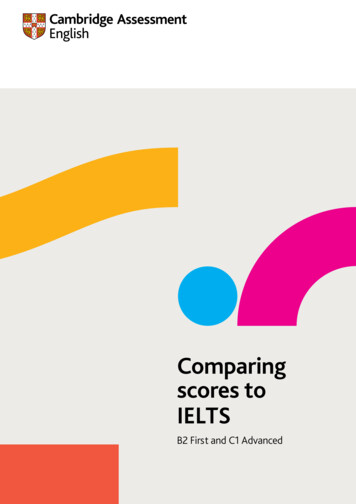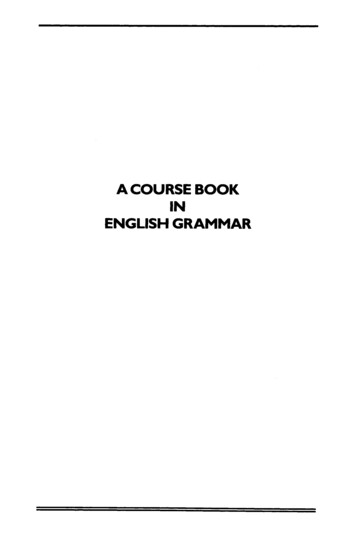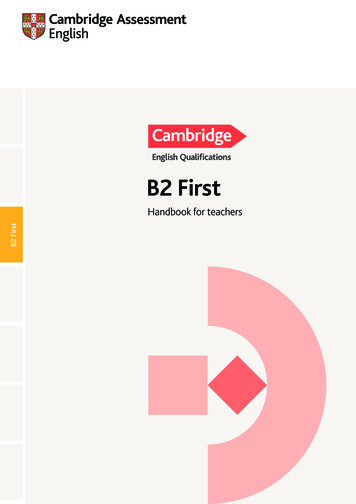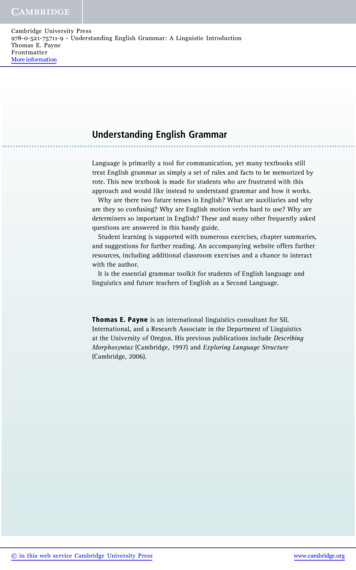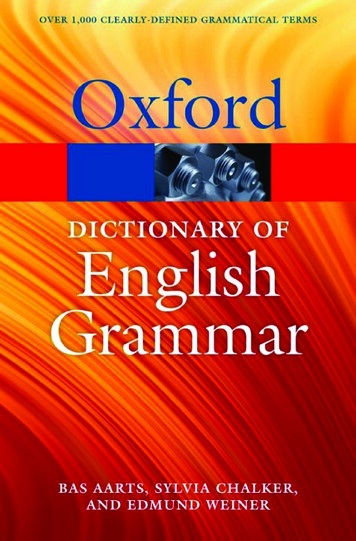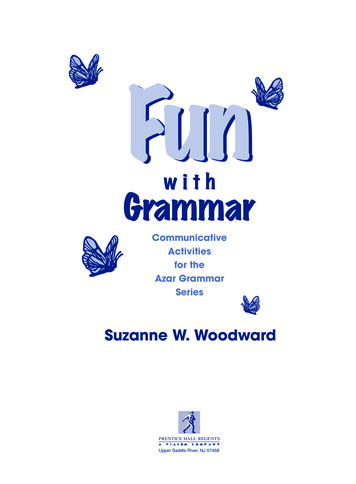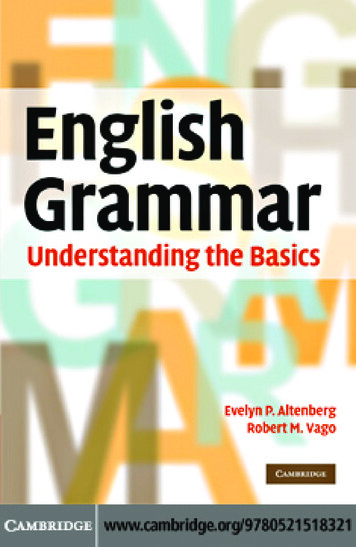
Transcription
This page intentionally left blank
English GrammarUnderstanding the BasicsLooking for an easy-to-use guide to English grammar? This handy introductioncovers all the basics of the subject, using a simple and straightforward style.Students will nd the book’s step-by-step approach easy to follow and be encouraged by its non-technical language. Requiring no prior knowledge of English grammar, the information is presented in small steps, with objective techniques to helpreaders apply new concepts. With clear explanations and well-chosen examples,the book gives students the tools to understand the mysteries of English grammaras well as the perfect foundation from which to move on to more advanced topics.E V E L Y N P . A L T E N B E R G is Professor in the Department of Speech-Language-HearingSciences at Hofstra University, NewYork.R O B E R T M . VA G Ois Professor and Chair in the Department of Linguistics andCommunication Disorders at Queens College, City University of NewYork.
EnglishGrammarUnderstanding the BasicsEV E LY N P. A LT EN B E RGHofstra UniversityandROB E RT M . VAG OQueens College and the Graduate CenterCity University of NewYork
CAMBRIDGE UNIVERSITY PRESSCambridge, New York, Melbourne, Madrid, Cape Town, Singapore,São Paulo, Delhi, Dubai, TokyoCambridge University PressThe Edinburgh Building, Cambridge CB2 8RU, UKPublished in the United States of America by Cambridge University Press, New Yorkwww.cambridge.orgInformation on this title: www.cambridge.org/9780521518321 Evelyn P.Altenberg & Robert M.VagoThis publication is in copyright. Subject to statutory exception and to theprovision of relevant collective licensing agreements, no reproduction of any partmay take place without the written permission of Cambridge University Press.First published in print format 2010ISBN-13978-0-511-72945-4eBook 3978-0-521-73216-1PaperbackCambridge University Press has no responsibility for the persistence or accuracyof urls for external or third-party internet websites referred to in this publication,and does not guarantee that any content on such websites is, or will remain,accurate or appropriate.
To my husband, Jim, my daughters, Jen and Alli,my mother, Lilo, and in memory of my father, HansandTo my son, Joel, so that he might read this book andunderstand what his father was trying to teach him
ContentsIntroductionpage xiHow to use this bookxiiPart I Kinds of wordsUnit INouns13Lesson 1 Identifying nouns3Lesson 2 Concrete and abstract nounsLesson 3 Singular and plural nouns59Lesson 4 Animate and inanimate nouns12Lesson 5 Count and noncount nouns14Lesson 6 Proper and common nouns18Answer keys: Test yourself questions Unit 1Unit 2Verbs23Lesson 7Identifying verbsLesson 8The verb base23Lesson 9Action verbs and linking verbs2527Lesson 10 Transitive and intransitive verbsLesson 11 Phrasal verbsDeterminers46Lesson 13 DemonstrativesLesson 14 Possessives50Lesson 15 Quanti ers5348Answer keys: Test yourself questions Unit 3Adjectives58Answer keys: Test yourself questions Unit 4Prepositions65Answer keys: Test yourself questions Unit 5Conjunctions6365Lesson 17 Identifying prepositionsUnit 65558Lesson 16 Identifying adjectivesUnit 54145Lesson 12 ArticlesUnit 43538Answer keys: Test yourself questions Unit 2Unit 3206869Lesson 18 Coordinating conjunctionsLesson 19 Subordinating conjunctions7073vii
ContentsLesson 20 Correlative conjunctions77Answer keys: Test yourself questions Unit 6Unit 7Pronouns7981Lesson 21 Subject and object pronounsLesson 22 Re exive pronouns8285Lesson 23 Demonstrative pronounsLesson 24 Possessive pronounsLesson 25 Interrogative pronounsLesson 26 Relative pronouns87899396Answer keys: Test yourself questions Unit 7Unit 8Adverbs99103Lesson 27 Identifying adverbs103Answer keys: Test yourself questions Unit 8Review matching exercise and answer key Part IPart II Kinds of phrasesUnit 9Noun phrases107109111113Lesson 28 The basic structure of noun phrasesAnswer keys: Test yourself questions Unit 9Unit 10 Prepositional phrases113119121Lesson 29 The basic structure of prepositional phrasesAnswer keys: Test yourself questions Unit 10Unit 11 Verb phrases125126Lesson 30 The basic structure of verb phrasesAnswer keys: Test yourself questions Unit 11Unit 12 Auxiliary phrases126135138Lesson 31 The basic structure of auxiliary phrasesLesson 32 Modals141Lesson 33 Perfect have143Lesson 34 Progressive be146Lesson 35 Combining auxiliary verbs148Lesson 36 The su xes of auxiliary verbsLesson 37 Tense151156Answer keys: Test yourself questions Unit 12Unit 13 Subjects and objects169Lesson 38 Subjects170Lesson 39 Direct objectsLesson 40 Indirect objects173177Lesson 41 The functions of pronounsviii183164139121
ContentsLesson 42 Implied subjects: commands186Answer keys: Test yourself questions Unit 13Unit 14 Compound phrases189193Lesson 43 Compound noun phrases194Lesson 44 Compound verb phrases195Answer keys: Test yourself questions Unit 14Review matching exercise and answer key Part II197198Part III Getting started with sentencesUnit 15 The functions of sentences201203Lesson 45 Identifying sentences by function203Answer keys: Test yourself questions Unit 15Unit 16 Combining sentences206207Lesson 46 Simple sentencesLesson 47 Compound sentences207210Lesson 48 Complex sentences214Lesson 49 Sentences with relative clauses221Lesson 50 Compound-complex sentences229Answer keys: Test yourself questions Unit 16Unit 17 Related sentences231235Lesson 51 Looking at related sentences235Lesson 52 Active and passive sentences238Lesson 53 Positive and negative sentences246Answer keys: Test yourself questions Unit 17250Review matching exercise and answer key Part IIIList of Quick tipsGlossaryIndex252253261270ix
IntroductionOur goal in this book is to help you learn about English grammar in as simple and straightforward a way as possible. The book was inspired by our students, most of whom panicwhen we say words like adjective, subject, and passive. We believe that panic will bereplaced by knowledge and con dence as readers work their way through this userfriendly book.Who is this book for? It’s for anyone who needs or wants to understand English grammar. That includes readers who: (1) want to improve their writing; (2) are studying a foreign language; (3) are or want to be teachers; (4) are learning English as a secondlanguage; (5) are or want to be professionals such as speech language pathologists andattorneys; (6) are interested in how English works. The book is self-guided and selfpaced; it can be used alone or as part of a course.The workbook approach used here will move you beyond simply labeling words to anunderstanding of how the di¡erent pieces of a sentence t together. To help you achievethis understanding, we present information in small steps, with many opportunities toapply each new piece of information in exercises before you move on to the next step.Like all languages, English is a collection of dialects.While society views some of thesedialects as having more social prestige than others, when we look at them objectively we nd that all dialects are equal linguistically.That means that all dialects have grammatical rules, and the grammatical rules of one dialect are no more precise, pure, or logicalthan the grammatical rules of another dialect. Nonetheless, in this book we focus on thegrammar of Standard American English because it is widely known and because writingrequires a knowledge of formal, standard English.We deliberately limit this introductory book in both content and complexity.Whereverpossible, we provide you with a simple rule of thumb to use. However, we don’t claim tocover all of English sentence structure. A clear understanding of what usually workswill give you a foundation for recognizing and understanding the exceptions. Our aim isto provide you with the basics.This book will clarify English sentence structure and provide you with a useful reference book that you can turn to long after you’ve completed the exercises. It will also provide you with a solid foundation for more advanced study.So take a deep breath and turn the page.We predict that it won’t hurt a bit. In fact, youmay be surprised to nd out how easy English Grammar can be.xi
How to use this bookWhat are the features of this book that will help you use it effectively?*We assume no prior knowledge of English grammar. Depending on your backgroundand interest, you can either work the book through from cover to cover or just readabout selected topics.*We utilize user-friendly, easy-to-understand language, avoiding excessive technicalterminology.*Information is presented in lesson format; most lessons are short, helping to make thematerial manageable.*Numerous exercises allow you to test yourself after new information is presented; theexercises gradually incorporate more knowledge while building on prior information.*Each exercise has a sample item done for you, to help you with the exercise.*Each exercise is separated into two parts: Getting started and More practice.With eachGetting started part, we provide a page reference to the answers, so you’ll immediatelyknow whether or not you’re on the right track. For More practice items, answers are pro-*vided on the accompanying website.In addition to exercises, each lesson contains easy to nd Quick tips.These provide convenient ‘‘tricks’’ to help you master the material or highlight the main concepts in eachlesson.*We’ve also included short sections called To enhance your understanding. These sections are intended for those of you who are interested in more than basic information.These sections can easily be skipped by beginners; they’re not necessary for understanding any material later on in the book.*Throughout the text, ungrammatical sentences are identi ed with an asterisk (*) at thebeginning.How is this book organized?*The book has three parts: Part I deals with types of words, Part II with types of phrases,and Part III with types of sentences.*Each part is divided into units and each unit is subdivided into related lessons.*Each lesson contains ample Test yourself exercises. Each exercise has ten questions,*with answer keys provided at the end of each unit and on the accompanying website.A review matching exercise with an answer key is included at the end of each part.*Additional review exercises for each unit are provided on the companion website.*For easy reference, the end of the book contains a list of all Quick tips, a detailed glossary, and an index.Website: www.cambridge.org/altenberg-vagoxii
PART I: KINDS OF WORDSDo you shudder when you hear the words noun or verb? Don’t worry you already know allabout word categories, also known as parts of speech, though you may not think you do.You know, for example, that you can say the idea and the boy but not *the about or *happythe. (As stated in the How to use this book section, an asterisk [*] is used to indicate thatsomething is ungrammatical.) That is, you know that some words can go in some placesin a sentence and others can’t. Aword category, or part of speech, is just a name given to agroup of words that have something in common, such as where they can go in a sentence.Part I gives you a quick and easy guide to basic word categories.
UNIT 1: NOUNSLesson 1: Identifying nounsNouns are commonly de ned as words that refer to a person, place, thing, or idea.How can you identify a noun?Quick tip 1.1If you can put the word the in front of a word and it sounds like a unit, the wordis a noun.For example, the boy sounds like a unit, so boy is a noun. The chair sounds like a unit, sochair is a noun. Compare these nouns to *the very, *the walked, *the because.Very, walked,and because are not nouns. While you can easily put the and very together (for example,the very tall boy), the very, by itself, does not work as a unit while the chair does. So, chair isa noun; very is not. (There is one kind of noun that cannot always have the in front of it;see Lesson 6 later in this unit.)Test yourself 1.1Which of the following words are nouns? See if they sound like a unit when you put them here:the. Check the appropriate column.NounSample: alwaysNot a noun.Getting started (answers on p. 20)1. tree.More practice (answers on the website).6. slowly.2. when.7. factory3. beds.8. ticket.4. glass.9. boxes.5. said.10. almost.Test yourself 1.2Underline the nouns in these phrases. Test each word to see if it sounds like a unit when you put it.here: theSample: all my friendsGetting started (answers on p. 20)1. your red sweater4. many digital photos2. those boxes5. his very interesting article3. a few men3
UNIT 1: NOUNSMore practice (answers on the website)6. their carpets7. a hand-painted plate8. the court stenographer49. our psychology professor10. two interesting museums
Lesson 2: Concrete and abstract nounsHere’s an unusual sentence: He smelled the marriage.What makes this sentence unusual isthat we don’t generally think of the noun marriage as something that can be smelled. Somenouns are concrete: they can be perceived by our senses they are things that we can see,hear, smell, taste, or touch.Those nouns that are not concrete are abstract. Marriage is something abstract, so it’s odd to say it’s being perceived by one of our senses, our sense of smell.The nouns in Lesson 1 were all concrete nouns. Other nouns, such as marriage, areabstract; this means that they refer to things that you cannot perceive with your senses,things you cannot see, smell, feel, taste, or touch. Here are some more concrete andabstract yculturejewelrymindQuick tip 2.1Concrete nouns refer to things we can perceive with one of our senses. Abstract nounscannot be perceived by our senses.Test yourself 2.1Decide if each noun is concrete or abstract.Sample: discussionabstractGetting started (answers on p. 20)1. mu n2. violin3. freedom4. elegance5. trainMore practice (answers on the website).6. friend.7. friendliness.8. economics.9. dormitory.10. capitalism.Test yourself 2.2Which of the following words are nouns? See if they sound like a unit when you put them here:the.The nouns will all be abstract nouns. Check the appropriate column.NounSample: confusionNot a noun.5
UNIT 1: NOUNSGetting started (answers on p. 20)More practice (answers on the website)1. concept.6. ran.2. shockingly.7. secret.3. wrote.8. her.4. conversation .9. death.5. interview.10. jobAn abstract noun is sometimes easier to identify if you create a sentence with it. For example,the happiness is a unit, as can be seen in The happiness on her face delighted him.Thus, happiness is a noun. Here are some other abstract nouns in sentences; the nouns are underlined.1. It was not the complaint which bothered him.2. They were attempting to stop the abuse.3. The joy which they felt was obvious.Another easy way to identify a noun, especially an abstract noun, is to put the word his(or other words like it see Lesson 21) in front of it and see if it sounds like a unit. For example, his complaint, his happiness, his concern all are units; therefore, complaint, happiness,and concern are nouns.Quick tip 2.2If you can put his in front of a word and it sounds like a unit, the word is a noun.Test yourself 2.3Which of the following words are nouns? See if they sound like a unit when you put them here:.The nouns will all be abstract nouns. Check the appropriate column.hisNounSample: obligationNot a noun.Getting started (answers on p. 20)More practice (answers on the website)1. jumped.6. closed.2. appropriate.7. celebration.3. popularity.8. their.4. emotions.9. news.5. real.10. spokenTest yourself 2.4Which of the following words are nouns? These are a mix of concrete and abstract nouns. Check theappropriate column.NounSample: while6.Not a noun
Lesson 2: Concrete and abstract nounsGetting started (answers on p. 21)More practice (answers on the website)1. repair.6. obstruction.2. intelligence.7. pounds.3. a.8. disgraceful.4. skis.9. complicated.5. us.10. sinceTest yourself 2.5Underline the nouns in the sentences below. In this exercise, the nouns will all have the or his in frontof them. Some will be concrete and some will be abstract. Some sentences have more than one noun.Sample: His answer wasn’t helpful.Getting started (answers on p. 21)More practice (answers on the website)1. She read the play over again.6. The glitterati always like to follow thefashion of the day.2. The actions became monotonous.7. They will repair his stove.3. He felt that his marriage, his relationshipwith her, was strong.8. The arrangement was good for all of them.4. The time had nally come to confess the9. The audience stared at the screen,truth.fascinated by the action they were seeing.5. He’s the boy who delivers the paper.10. The de nition was in his dictionary.The nouns are underlined in the following sentences:4. This author lives with her husband.5. Do most people proceed contentedly through life?6. Your photograph of that child sleeping won you a prize.As you can see from these sentences, while theor hisare ways to test a word tosee if it’s a noun, a noun doesn’t necessarily have the or his in front of it in every sentence.Since we can say the author, the husband, the people, his life, the photograph, his child, andhis prize, the underlined words in sentences 4 6 are each nouns.Test yourself 2.6Underline the nouns in the sentences below. In this exercise, the nouns will not all have the or hisin front of them. Just test each word to see if it can be a noun.Sample: The repair of my camera went smoothly.Getting started (answers on p. 21)More practice (answers on the website)1. I wrote every word of the letter.6. A group of three generals sent the troops away.2. The house was near the city.7. The ag was near your desk.3. Why did he get on an elevator?8. My mother acted in a play.4. She has my phone.9. He called the house every day.5. Your younger brother was busy.10. You have to give her salary and bene ts.7
UNIT 1: NOUNSIt’s important to realize that the same word can often be used as more than one part ofspeech. For example, repair can be used as a noun (example: The repair was relatively inexpensive), as an adjective (example: The repair manual was not very helpful), or as a verb(example: He needs to repair the washing machine).We’ll talk about verbs and adjectives inUnits 2 and 4, respectively.8
Lesson 3: Singular and plural nounsWhat’s the di¡erence between cat and cats? The noun cat is used when it refers to only onecat; its form is singular. The noun cats is used when it represents more than one cat; itsform is plural. Thus, the singular and plural forms tell us about number. Below are somenouns in their singular and plural scountrycountriesmanchildmenchildrenTest yourself 3.1Underline each noun in the sentences below and indicate whether it is singular (SG) or plural (PL).There may be more than one noun in a sentence.Sample: They used her computer (SG) to download the les (PL).Getting started (answers on p. 21)More practice (answers on the website)1. He had a few good ideas.6. Sharks live in water.2. The boys spoke in a quiet whisper.7. Yesterday, I caught a big trout.3. The tourists greeted the queen with attitudes8. There are many beautiful homes on this block.of respect.9. Visitors to this country must obtain visas.4. My neighbor is a neurologist.5. The exterminator found bugs in the o ce.10. His cousin fought in a brutal battle to freeninety hostages.Regular and irregular pluralsUsually, we pluralize a noun by adding an‘‘s’’ to it, as in books; these nouns are called regular.There are a handful of nouns that are pluralized in other ways; these nouns are calledirregular.Irregular nouns form their plural in di¡erent ways. Here are some common patterns:1. changing a vowel: man/men, for example2. adding ‘‘ren’’or ‘‘en’’: child/children, for example3. adding nothing: sh/ sh, for example4. changing ‘‘f ’’ to‘‘v’’and then adding ‘‘s’’: knife/knives, for exampleTest yourself 3.2Underline each plural noun in the sentences below and indicate if it is regular (REG) or irregular(IRREG) in terms of how it is pluralized.Sample: The women (IRREG) received their education at some exclusive schools (REG).9
UNIT 1: NOUNSGetting started (answers on p. 21)1. The doctor treated most of the patients whoMore practice (answers on the website)6. Those husbands and wives lead interestingwere waiting.lives.2. The geese crossed the road near my car.7. Her feet have grown since last year.3. She set a trap to catch the mice that had8. The back window of my apartmentinvaded her kitchen.4. You will have to feed the oxen mostafternoons.5. Whenever I travel to the countryside,overlooks about a dozen roofs.9. The salesmen surrounded me in theshowroom.10. Kenneth had to buy two bottles ofI see many sheep, ducks, deer, anddisinfectant to get rid of the lice in hiscows.bathroom.To enhance your understandingWhat is the plural of the ‘‘word’’ blun? Even though you’ve probably never seen thisnonsense word, you’re likely to say its plural is bluns. That’s because we don’t have tomemorize the ending of regular plurals; we simply use our plural formation rule: ‘‘add s.’’But the forms for irregular plural words, like children and men, need to be memorized sincethey don’t follow a consistent pattern.To further enhance your understandingEarlier we said that we usually pluralize a noun in English by adding an ‘‘s’’ to it. There’sactually more to it than that, when one examines the pronunciation of regular nouns moreclosely.Here are some regular English nouns:ABcatdoglipbeemythcarlaughdealSay each word in column A out loud, adding its plural ending. (Don’t whisper, or thiswon’t work.) You’ll notice that, as you expect, you’re adding an [s] sound to each word.(Symbols in square brackets [ ] indicate sounds rather than letters.) Now say each word incolumn B out loud, adding its plural ending. If you listen carefully, you’ll notice that you’renot adding an [s] sound to each word to make it plural. You’re actually adding a [z] sound!(If English is not your native language, you may not be doing this.)It turns out that we learned, when we were acquiring English as children, that it is the lastsound, and not letter, of a regular noun that determines whether we add [s] or [z]. Somesounds (voiced sounds) are made with our vocal cords vibrating, like the strings of a guitar.Try this: hold your hand touching your throat, about where a man’s Adam’s apple is, whileyou say and hold a [v] sound ([v v v v v . . . ]). You’ll feel the vibration of your vocal cords.10
Lesson 3: Singular and plural nounsOther sounds (voiceless sounds) are made with our vocal cords not vibrating. Now touchyour hand to your throat again and this time say and hold an [f] sound ([f f f f f . . . ]); you willnotice the lack of vibration.So how do we know whether to say the plural with an [s] or [z] sound? If the last sound ofa word is a voiceless sound, we add an [s] sound to make it plural. If the last sound of a wordis a voiced sound, we add a [z] sound to make it plural. This is not a rule that someone hasever taught us, but part of our unconscious knowledge of English.Notice that having an [s] sound after voiceless sounds makes sense: [s] itself is voiceless.By the same reasoning, having a [z] after voiced sounds also makes sense: [z] itself isvoiced. So what you can see is that the last sound of the noun and the sound of the regularplural share the same voicing characteristic: either the vocal cords vibrate for both sounds,or they don’t.You may have noticed that there’s actually a third type of regular noun. Say the followingwords out loud, adding the plural ending to each:glassmazewishgaragechurchjudgeThese words all already end in sounds (again, not letters) that are either [s] or [z] or soundsvery similar to them. They are all ‘‘noisy’’ sounds. For the plural forms of these words, weadd a vowel sound (written with the letter e) followed by a [z] sound (but written with theletter s): glasses, mazes, wishes, garages, churches, judges. If you think about it, pronouncing a vowel between the noisy sound at the end of the noun and the noisy sound [z] of theplural makes sense: without that vowel, we would have two noisy sounds in a row,something that would be harder for the listener to hear clearly.Wow! You may want to just pause for a moment here and contemplate the complexity ofwhat you know about your language. And you knew how to do this before you even wentto kindergarten! You just haven’t known that you know it.11
Lesson 4: Animate and inanimate nounsTake a look at the following sentence:1. The postcard saw the mailman.What’s strange about this sentence? What’s strange is that we don’t expect a postcard,which is not alive, to be able to see something; only things that are alive have the abilityto see. Nouns that refer to things that are alive are called animate, while nouns that referto things that are not alive are called inanimate. Postcard is an inanimate noun andusing it as an animate one makes for a very unusual sentence.Quick tip 4.1Animate nouns refer to things that are alive; inanimate nouns refer to things that arenot alive.Test yourself 4.1Decide if each noun is animate or inanimate.Sample: appleinanimateGetting started (answers on p. 21)1. word2. lizard3. glassesMore practice (answers on the website).6. criminal.7. furniture.8. doctor4. calendar.9. mouse5. baby.10. truck.Now take a look at the following sentence:2. The dog wrote a best-selling novel.Again, there’s something strange here.We know that dog is animate. However, only a specialtype of animate noun has the ability to write a best-selling novel: a human noun.The following sentence is ne, since teacher is a human animate noun: My teacher wrote a best-sellingnovel. On the other hand, since dog is a nonhuman animate noun, sentence 2 does not soundright.To summarize: nouns may be human animate (teacher), nonhuman animate (dog), orinanimate (postcard).Test yourself 4.2Decide if each noun is animate or inanimate. If a noun is animate, decide if it is human or nonhuman.Sample: chair12inanimate
Lesson 4: Animate and inanimate nounsGetting started (answers on p. 21)More practice (answers on the website)1. dinner.6. tablecloth.2. pet.7. recipes.3. friend.8. assassin.4. child.9. shark.5. spider.10. freedom.13
Lesson 5: Count and noncount nounsLet’s take a closer look at the noun hand. Notice that you can say the following:the handa handhandsHere are some other nouns which demonstrate the same pattern:the storea storestoresthe ideathe tissuean ideaa tissueideastissuesLet’s compare
English Grammar Understanding the Basics Looking for an easy-to-use guide to English grammar? This handy introduction covers all the basics of the subject, using a simple and straightforward style. Students will nd the book’s step-by-step approach easy t


